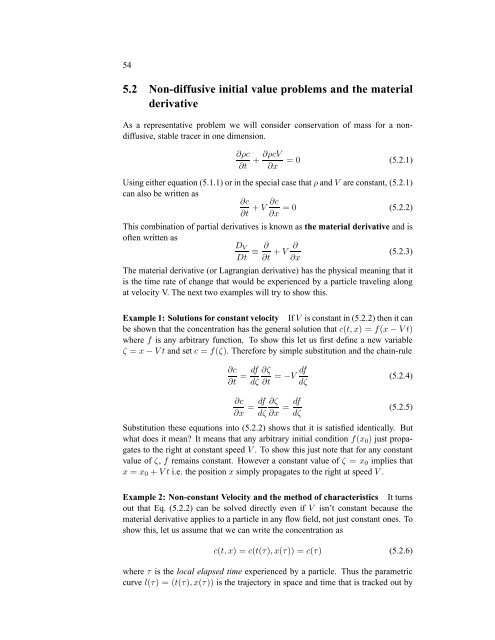Transport: Non-diffusive, flux conservative initial value problems and ...
Transport: Non-diffusive, flux conservative initial value problems and ...
Transport: Non-diffusive, flux conservative initial value problems and ...
You also want an ePaper? Increase the reach of your titles
YUMPU automatically turns print PDFs into web optimized ePapers that Google loves.
54<br />
5.2 <strong>Non</strong>-<strong>diffusive</strong> <strong>initial</strong> <strong>value</strong> <strong>problems</strong> <strong>and</strong> the material<br />
derivative<br />
As a representative problem we will consider conservation of mass for a non<strong>diffusive</strong>,<br />
stable tracer in one dimension.<br />
∂ρc<br />
∂t<br />
+ ∂ρcV<br />
∂x<br />
= 0 (5.2.1)<br />
Using either equation (5.1.1) or in the special case that ρ <strong>and</strong> V are constant, (5.2.1)<br />
can also be written as<br />
∂c ∂c<br />
+ V = 0<br />
∂t ∂x<br />
(5.2.2)<br />
This combination of partial derivatives is known as the material derivative <strong>and</strong> is<br />
often written as<br />
DV ∂ ∂<br />
≡ + V<br />
Dt ∂t ∂x<br />
(5.2.3)<br />
The material derivative (or Lagrangian derivative) has the physical meaning that it<br />
is the time rate of change that would be experienced by a particle traveling along<br />
at velocity V. The next two examples will try to show this.<br />
Example 1: Solutions for constant velocity If V is constant in (5.2.2) then it can<br />
be shown that the concentration has the general solution that c(t,x) = f(x − V t)<br />
where f is any arbitrary function. To show this let us first define a new variable<br />
ζ = x − V t <strong>and</strong> set c = f(ζ). Therefore by simple substitution <strong>and</strong> the chain-rule<br />
∂c<br />
∂t<br />
df ∂ζ<br />
=<br />
dζ ∂t<br />
= −V df<br />
dζ<br />
∂c df ∂ζ df<br />
= =<br />
∂x dζ ∂x dζ<br />
(5.2.4)<br />
(5.2.5)<br />
Substitution these equations into (5.2.2) shows that it is satisfied identically. But<br />
what does it mean? It means that any arbitrary <strong>initial</strong> condition f(x0) just propagates<br />
to the right at constant speed V . To show this just note that for any constant<br />
<strong>value</strong> of ζ, f remains constant. However a constant <strong>value</strong> of ζ = x0 implies that<br />
x = x0 + V t i.e. the position x simply propagates to the right at speed V .<br />
Example 2: <strong>Non</strong>-constant Velocity <strong>and</strong> the method of characteristics It turns<br />
out that Eq. (5.2.2) can be solved directly even if V isn’t constant because the<br />
material derivative applies to a particle in any flow field, not just constant ones. To<br />
show this, let us assume that we can write the concentration as<br />
c(t,x) = c(t(τ),x(τ)) = c(τ) (5.2.6)<br />
where τ is the local elapsed time experienced by a particle. Thus the parametric<br />
curve l(τ) = (t(τ),x(τ)) is the trajectory in space <strong>and</strong> time that is tracked out by

















